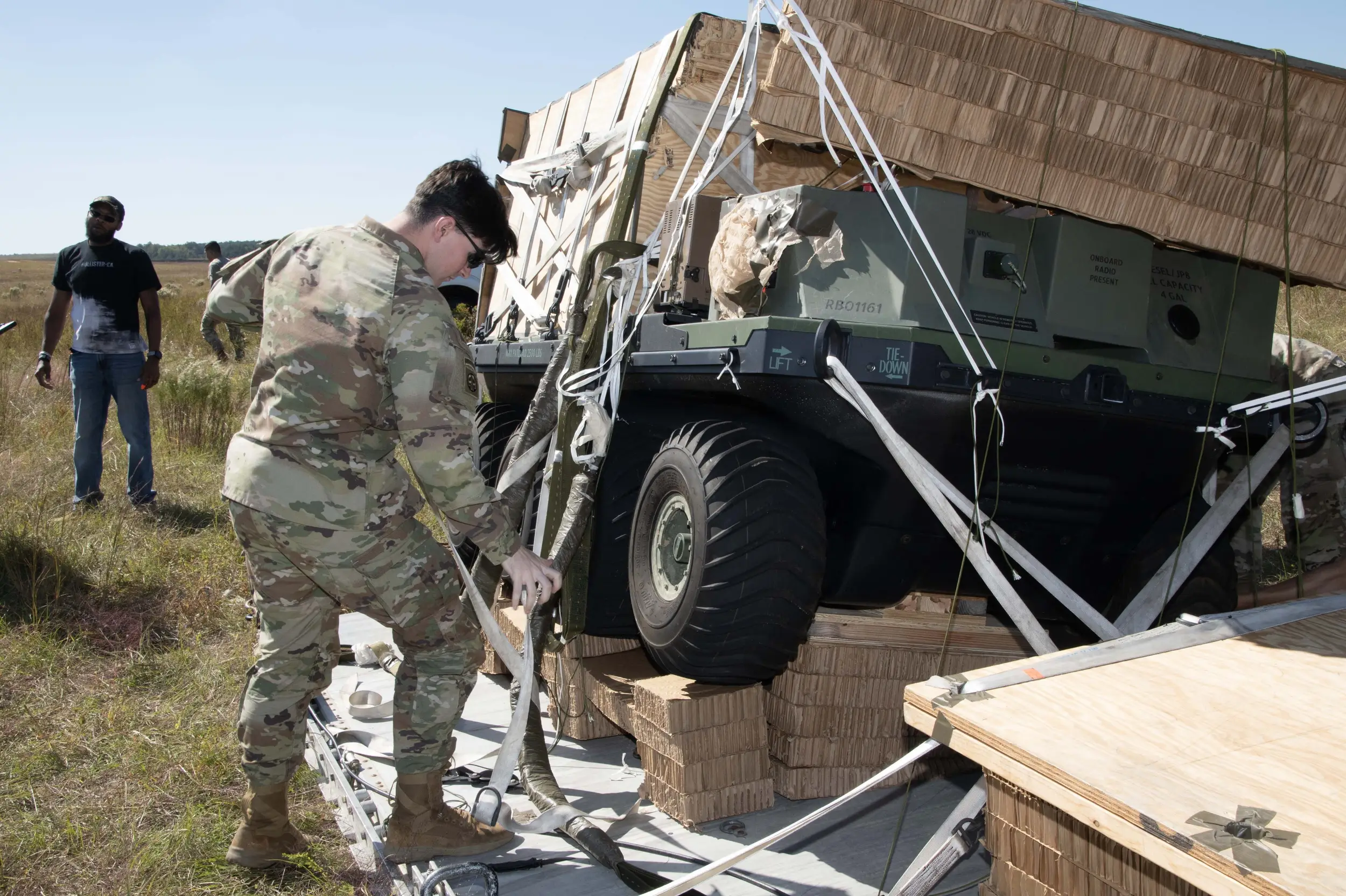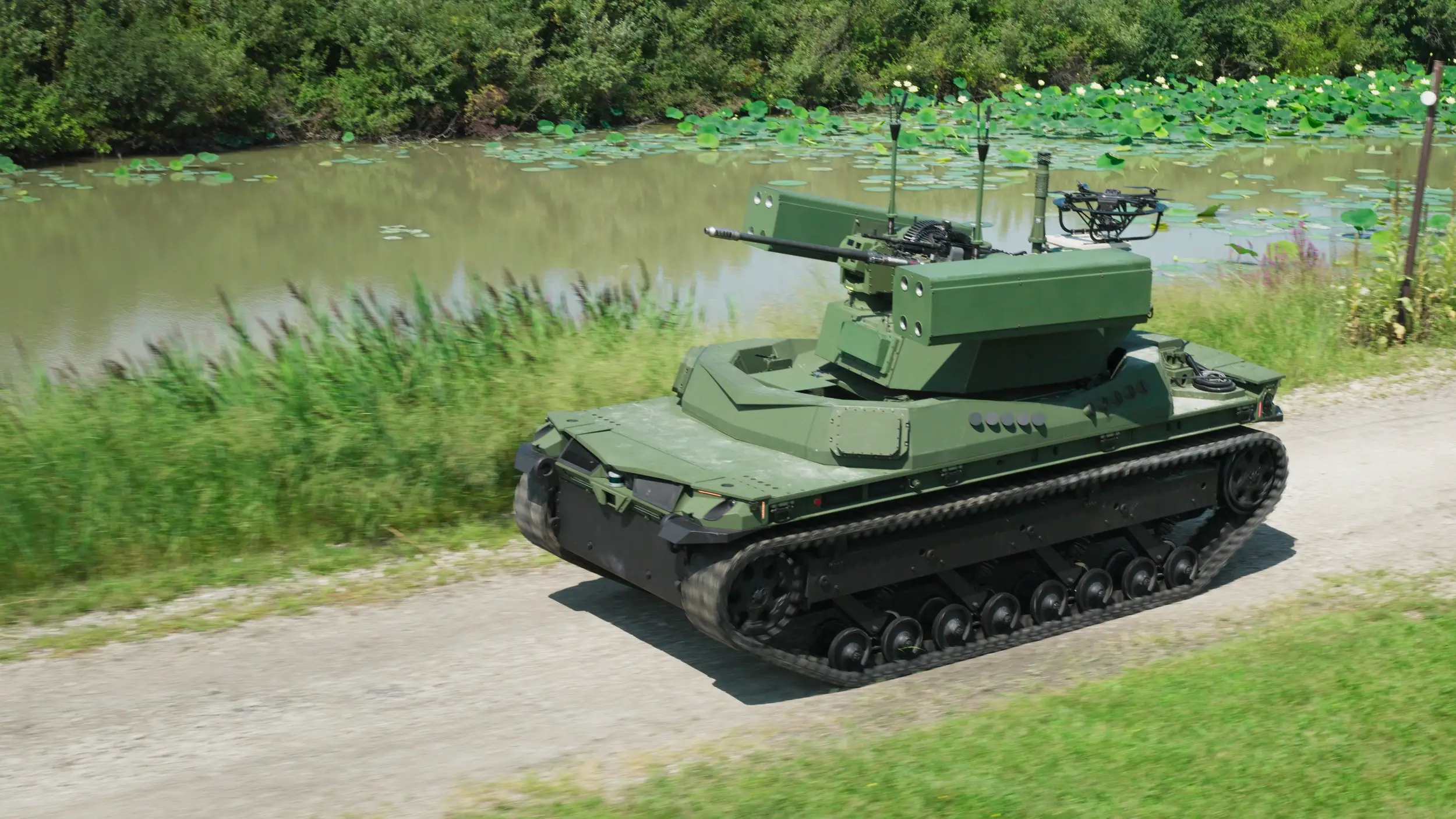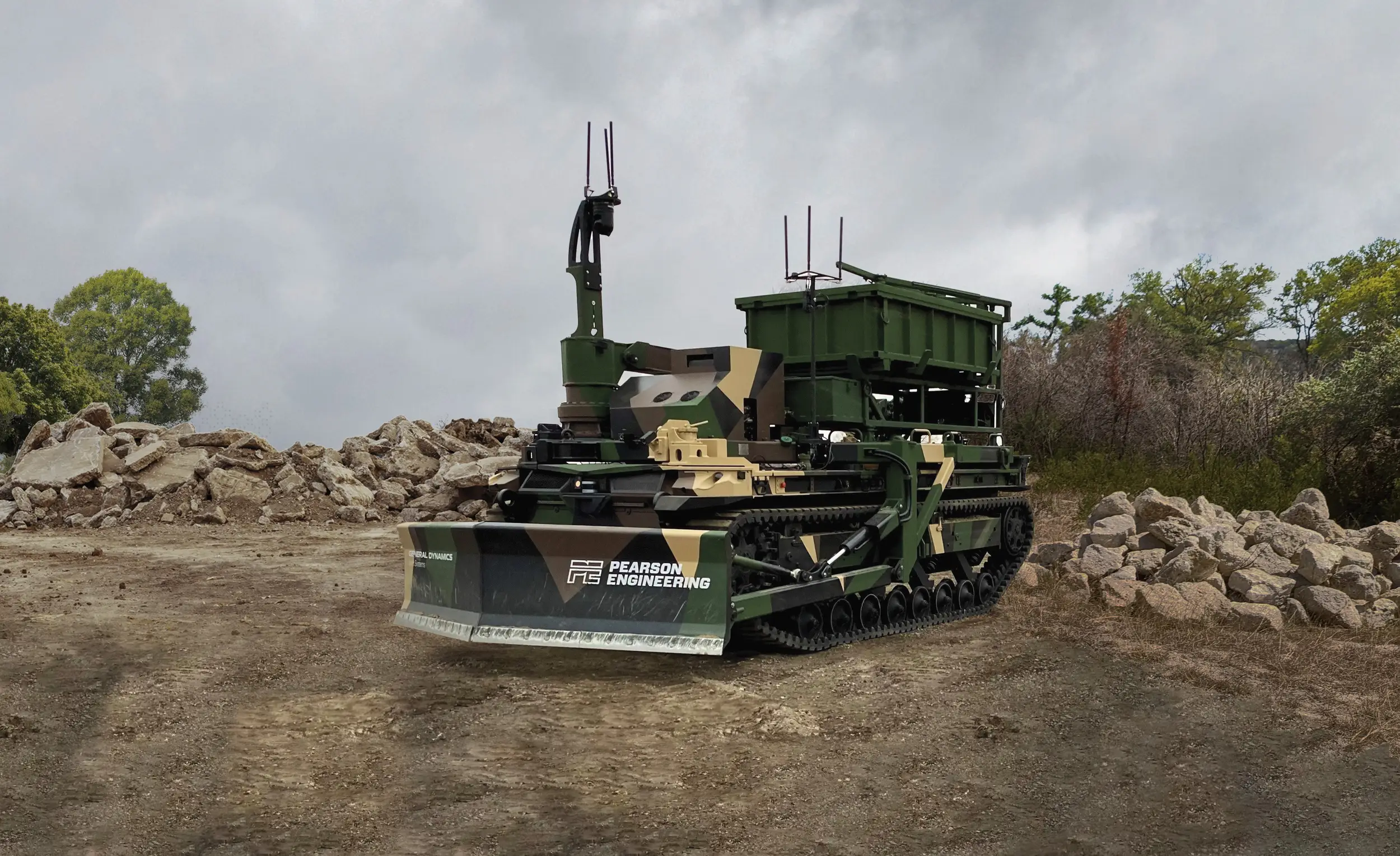
REPORT HOME > tactical enablers
MAY 2024 | technology report | Armoured vehicles
As UGVs increasingly gain traction across the world’s major armed forces, Shephard dives into how their high levels of manoeuvrability and flexibility, combined with advanced autonomy and AI, can be game-changing for vital logistics and engineering work in the heat of battle.
Above: THeMIS has demonstrated applications in medevac, with the ability to mount at least two stretchers, and developer Milrem foresees its evolution across a wide range of combat and non-combat tasks. (Photo: Milrem Robotics)
Uncrewed ground vehicles (UGVs), robotic combat vehicles (RCVs) and remote-control applications are a growing focus for land forces, across various combat and ISR-focused roles. However, the systems also have significant applications in a range of support activities, from engineering to logistics and medical evacuation (medevac), according to military and industry experts.
The US Army is looking to the future of such systems through a range of programmes. One notable example is the RCV-Light programme, under which four companies – McQ, Textron Systems, General Dynamics Land Systems (GDLS) and Oshkosh Defense are developing platform prototypes.
Multirole mules
However, this is just one instance of the army’s work in the area. Rae Higgins, public affairs officer for the Program Executive Office – Combat Support & Combat Service Support (PEO CS&CSS) said the service’s robotic and autonomous programmes of record provide both an advantage in terms of ‘soldier stand-off’, as well as playing logistics roles as robotic ‘mules’.
For instance, she pointed to the Small Multipurpose Equipment Transport (S-MET) Increment I system, provided by GDLS based on its Multi-Utility Tactical Transport (MUTT) design. S-MET provides a single, radio-controlled platform designed to address capability gaps associated with excessive physical burdens, recharging batteries during continuous operations and reducing the sustainment burden for semi-independent operations.
‘The robotic nature of the system reduces the sustainment burden on S-MET-equipped units,’ Higgins said. ‘The requirement sponsor is working to incorporate Modular Mission Payloads (MMPs) capabilities such as autonomy, lethality, expanded communications, and casualty evacuation.’
Above: An S-MET is de-rigged following a drop test in North Carolina. A series of Modular Mission Payloads is under development for the squad-level system. (Photo: US Army)
Additionally, Higgins pointed to the Autonomous Tactical Vehicle System (ATV-S) programme, which will provide uncrewed operation of light wheeled vehicles in support of logistics missions. This would include support for convoy operations, waypoint navigation and teleoperations.
In December, the army announced Other Transaction Authority agreements had been awarded for ATV-S to Robotics Research Autonomous Industries, Neya Systems and Carnegie Robotics, which will see the companies build and deliver four prototypes.
At the time, Kent Shea, Product Manager (PM) for Robotic and Autonomous Systems, part of the Project Management Office for Force Projection in PEO CS&CSS, placed the development in the context of an evolving industrial background and a new battlespace environment.
‘Commercial technologies exist that will enable the army to close technological gaps and continue to advance autonomous capabilities in the future,’ Shea said. ‘Now is an opportune time to modernise with ATV-S in support of multi-domain operations in contested environments.’
Higgins added that ATV-S would reduce soldier exposure to hostile threats while increasing logistics throughput for convoy missions. Palletized Load System (PLS) Tactical Wheeled Vehicles (TWVs) equipped with ATV-S would allow a single soldier to lead a four-strong wirelessly linked convoy, reducing exposure to hostile threats while increasing transportation throughput.
Heavier metal
Ray Moldovan, business development manager at GDLS, said that lighter-weight vehicles like S-MET were well suited to provide support to the dismounted soldier, although the company’s larger platform – the Tracked Robot 10-ton, or TRX – is better suited to supporting ‘heavy-lift’ missions.
These could include ‘obstacle reduction, obstacle clearance, direct lethality and indirect fires’, he said, with a focus on scale for Stryker Brigade Combat Teams (SBCTs), Armored Brigade Combat Teams (ABCTs) and beyond.
‘UGVs are ideally suited to missions that would be considered dull, dirty or dangerous for a soldier or marine,’ Moldovan said. ‘For example, a resupply mission that involves movement between well-defined points over and over is great for autonomous-enabled UGVs.’
Leveraging a common mobility platform also reduces the training burden for operators and maintainers and minimises spare parts stockage requirements, said Moldovan.
‘UGVs also are suited for implementation of autonomy systems because they are not intended for human operation. With drive-by-wire architecture, scalable onboard computing, integrated modular sensors and network-ready payloads, UGVs are intended for offset line-of-sight and non-line-of-sight control.’
Above: The 10-ton TRX from GDLS is suited to supporting heavy-lift missions, including breaching and obstacle clearance as well as armed roles. (Photo: GDLS)
Breaching missions are the most dangerous of all, and therefore best executed by UGVs, said Moldovan. He pointed to the company’s partnership with Pearson Engineering in the UK which has developed a payload for TRX designed specifically for breaching.
‘The utility of UGVs such as MUTT and TRX cannot be overstated,’ Moldovan argued. ‘Each vehicle is designed to maximise payload-carrying capacity and offload power for integration of a wide range of mission equipment packages (MEP). They also are designed with an onboard data network that enables full integration of MEPs onto the vehicle, and also in the larger battlefield network.’
Autonomy solutions are part and parcel of the development process and continuously reviewed, Moldovan added. ‘As autonomy solutions improve and become more sophisticated, they will give back even more time to operators for high-value activities that only can be accomplished by humans.’
Dynamic background
A Pearson Engineering spokesperson highlighted the potential of UGVs and RCVs in combat engineering tasks, noting that these are ‘known to be particularly complex, with soldiers often exposed to artillery whilst undertaking critical tasks to support mobility, counter-mobility and survivability’.
Additionally, combat engineers require high levels of adaptability, with resources readily available to reconfigure to the evolving and dynamic nature of the battlefield, the spokesperson said. ‘Uncrewed vehicles offer the potential to address both of these challenges, reducing the peril to human life by taking people away from the most dangerous situations, and lending themselves to rapid deployment in a wide range of configurations to suit mission requirements.’
UGVs or RCVs that can breach a minefield with one mission payload before morphing to provide assault gap crossing will prove revolutionary for the modern battlefield and in the next generation of combat engineering, they said.
Pearson Engineering’s RCV-Pioneer system is designed to provide a teleoperated engineering capability. Each is tailored to specific combat engineering missions via payloads that can be rapidly swapped out in field conditions.
The concept is based on the principles of rapid interchangeability and agility. This allows the vehicles to scale and optimise for the task at hand, according to the company, whether supporting its own mobility or providing an engineering effect for others.
‘Uncrewed vehicles used for other tasks such as ISR and combat will also need to get to places of their commanders’ choosing in the same way as crewed vehicles,’ noted the Pearson Engineering spokesperson. ‘Without engineering assets to support, such vehicles would need human intervention to assure their mobility, ultimately undermining their value.’
Uncrewed ubiquity
Tõnu Niilo, capability development expert at Milrem Robotics, manufacturer of the THeMIS UGV and Type-X RCV, said such vehicles will play a significant role in non-combat roles looking forward.
‘UGVs are and will most certainly be used for carrying equipment and supplies in situations unsuitable for trucks or large, tracked vehicles,’ he commented. ‘The ability to carry more [equipment and supplies] enhances performance from the single soldier to the unit level. UGVs carry heavier equipment, including observation devices, and prevent soldiers from depleting energy.’
Milrem is looking at multiple fields of development for its UGVs beyond combat and ISR, Niilo said. This includes different aspects of engineering work, such as counter-IED and ensuring freedom of movement through the use of ploughs.
Additionally, he pointed to applications in medevac, noting that THeMIS can mount at least two stretchers, although the company is looking at the possibility of expanding this capability, including through the integration of medical monitoring devices.
Above: Pearson Engineering’s RCV-Pioneer system is designed to provide a teleoperated engineering capability for RCVs. (Photo: Pearson Engineering)
There is also ongoing work on the logistics side, he said, including automation, ‘with possible solutions for the last one-quarter mile, where even smaller-class vehicles might be helpful’.
Niilo also highlighted applications in communications and a range of other areas. ‘For any military force, the weak point today is its heavy reliance on communication systems. Although there have been advancements in communication technology to counter jamming and improve connectivity, the ultimate solution lies in enhancing the intelligence of robotics,’ he argued.
‘UGVs need to be able to gather information from various sensors and be able to move on the battlefield with minimal assistance and also help commanders with decision-making.’
Niilo said it can be counter-productive to talk of non-combat and combat roles for UGVs – rather, such systems should be assessed holistically.
‘Milrem Robotics is approaching the future of UGVs via a capability framework, where different types of robotic assets combined enable the commander to achieve the military effects they need. So saying that something is fulfilling a non-combat role might be misleading,’ he said.
‘As in most business cases, there are the doers (presumably something shooting or emitting) and the enablers (participating in combat by protecting, sustaining, etc). So one might [instead] say capability is achieved by a system of robotic systems.’
Advancements in AI will allow UGVs to perform such activities as combat engineering tasks both faster and more effectively, said the Pearson Engineering spokesperson, either through increased automation in the form of operator aids or full autonomy solutions allowing for ‘hands off’ modes.
‘Such solutions will ultimately reduce mission times, creating an unprecedented pace of advancement for friendly forces to counter the adversary – with minimal risk to personnel.’



